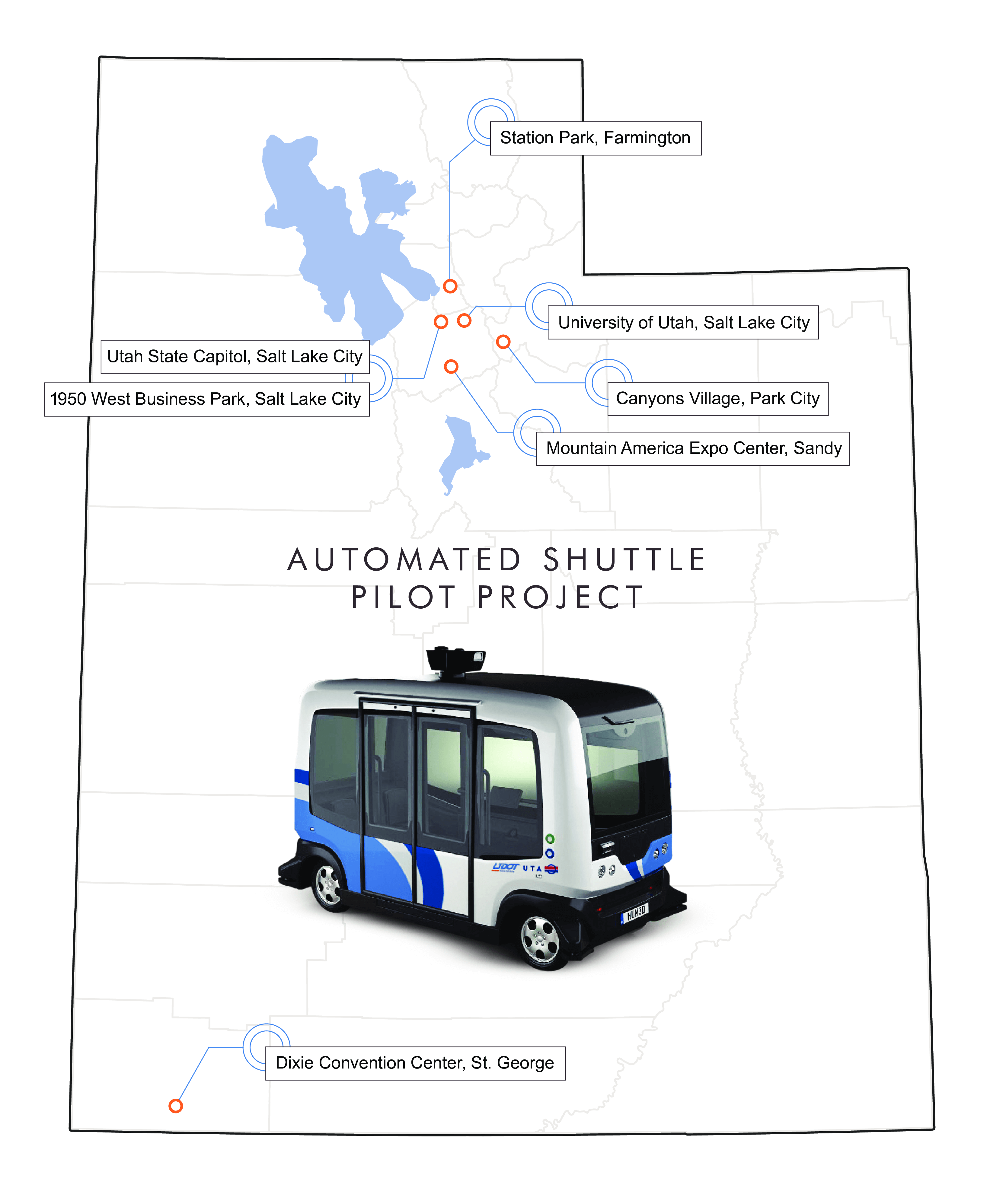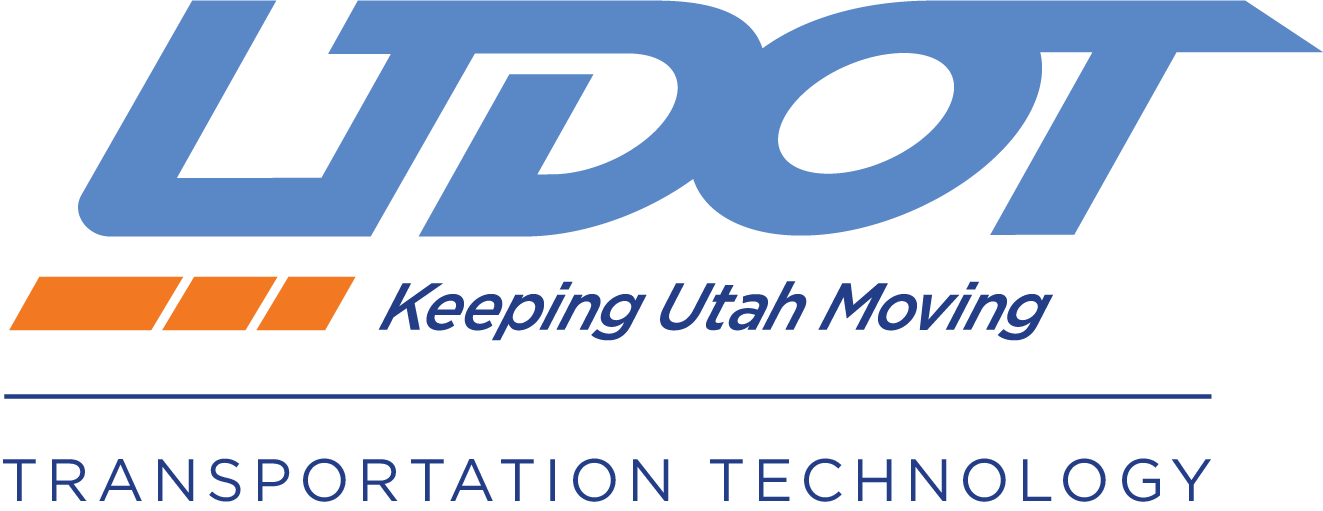Automated Shuttle Pilot Project
UDOT and the Utah Transit Authority (UTA) partnered to bring the Automated Shuttle Pilot Project to Utah in 2019 and 2020. The shuttle toured throughout the state to help the team learn about its capabilities and provide an opportunity for the public to experience a completely automated vehicle – meaning there is no driver, steering wheel or pedals. Public acceptance of automated vehicle technology is critically important. If people do not understand or trust the technology, they will be reluctant to use it and we will not achieve the benefits of this technology.
UDOT and the Utah Transit Authority (UTA) partnered to bring the Automated Shuttle Pilot to Utah. The Automated Shuttle Pilot was Utah’s first fully automated vehicle (AV), which means it did not have a driver, steering wheel, pedals, or other features usually associated with traditional vehicles. The project was deployed in April 2019 and will continue through September 2020.
The Automated Shuttle, which held up to 12 passengers, operated up to 15 miles per hour and was an all-electric vehicle. It followed a predetermined route but reacted to other vehicles, pedestrians, and other objects in real-time. A shuttle host was always on board to turn the vehicle on and off and to monitor operations. The shuttle has an automated ramp to assist those with mobility challenges in boarding the vehicle.
The shuttle operated with Level 4 driving automation, meaning the vehicle was capable of performing all driving tasks within specific conditions (such as only in the daytime or along a specific route) with no expectation that a human driver would be asked to intervene. The vehicle was leased from EasyMile, one of several companies that provide low-speed, automated shuttles.
QUICK FACTS
“During the 15-month pilot project, the automated shuttle carried over 6,727 riders and traveled nearly 1,347 miles.”
PURPOSES OF THIS PROJECT
UDOT and UTA had three primary purposes for this project:
- To evaluate the effectiveness of this type of driverless technology to connect people to and from transit lines, often referred to as the first-mile, last-mile, last-mile problem. Many people will not ride transit because their home or their destination is too far from a major bus or rail stop. The team explored if technology like this can help fill that gap and make transit more appealing to a larger group of people.
- To understand the operation and reliability of automated vehicles. As a low-speed vehicle that can only operate in certain types of traffic conditions, it was important to test and apply the technology in potential deployment scenarios. For example, how does the technology wirelessly communicate with traffic signals, what are the potential maintenance issues, and how long is the battery life in realistic operating conditions?
- To expose the technology to the public and learn about their attitudes and feelings. In national polls, the public generally expresses distrust about automated vehicles, but most have never experienced this type of vehicle technology. UDOT and UTA were interested to know how those attitudes were impacted by their experience of actually riding in a vehicle without a driver. Many riders are asked to respond to a brief survey, and more detailed studies of rider trust are underway with a small selection of riders. These public attitudes will influence the future deployments of automated technology and the roles that UDOT and UTA will play in that future.
A final report details the findings of the project.
BENEFITS OF THE PROJECT
The project focused on these four main benefits of automated vehicles:
- Safety was a key facet of the Automated Shuttle Pilot project. In fact, 94 percent of serious crashes are due to human error. This means that AVs can save lives and reduce injuries by removing human error.
- Automated vehicles could deliver economic and societal benefits by lowering the number of serious crashes. A 2018 survey shows that motor vehicle crashes cost Utah consumers $268 million.
- The Automated Shuttle Pilot is efficient and convenient. With more connected and automated vehicles (CAVs) on the roads, the vehicles would communicate with each other as well as with the infrastructure (such as traffic signals) to help increase driver efficiency and reduce congestion.
- CAVs can help improve access and increase mobility to meet the needs of Utah’s communities. For those with a disability, the elderly, or no direct access to public transit, this could provide a more independent life.
Automated shuttles, like the one deployed by UDOT and UTA, represent a small subset of the larger automated vehicle environment. The specific benefits of a vehicle like this, if deployed in some permanent locations, include improving transit efficiency and enhancing mobility for non-driving segments of the population. Continuing with deployments such as this also help to introduce this new technology to the public.
WHERE THE TECHNOLOGY IS DEPLOYED
The Automated Shuttle Pilot was deployed at various locations around the state, and it changed locations every few weeks. The shuttle has been deployed at the Canyons Village in Park City, Station Park in Farmington, a business Park in Salt Lake City, the University of Utah, the Utah State Capitol, the Mountain America Expo Center in Sandy, and the Dixie Convention Center in St George.
Since this shuttle did not meet the Federal Motor Vehicle Safety Standards that apply to traditional vehicles (this vehicle has no airbags or rear-view mirrors, for instance), the federal government needs to specifically approve operations of this vehicle. All shuttle sites and routes were vetted and approved in advance by the federal government.
Since this project was a pilot, it had specific objectives and a finite time frame. While permanent deployment scenarios are being discussed and evaluated, there are no definitive plans for shuttles like this to be deployed in Utah as of yet. Lessons from this pilot will inform potential future plans.
For more information about the Automated Shuttle Pilot project, including deployment site maps, schedules and photos, please visit http://www.avshuttleutah.com/.

